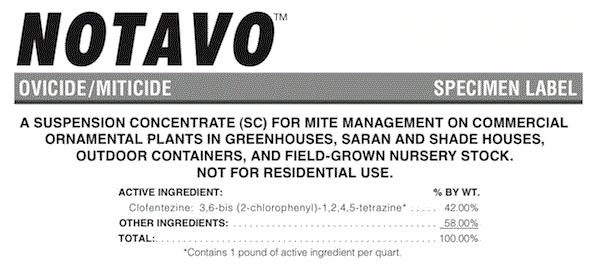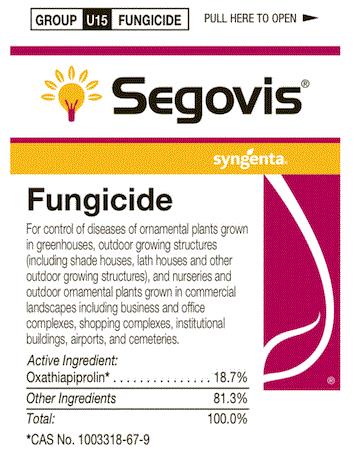GrowerTalks and Fine Americas release PGR guide for perennials
The 2018-2019 Growth Regulators for Containerized Herbaceous Perennial Plants has been released. This guide is a product of the partnership between GrowerTalks and Fine Americas.
I’ve been receiving the PGR Guide, and the associated Insecticide, Miticide & Fungicide Guide (also by GrowerTalks), since I was a wee graduate student during the age of flip phones. (To those eagerly helpful twenty-something at my local phone shop, my iPhone 5S carbon-dated me as someone from the age of dinosaurs.) If I don't get it in the mail I always make sure I get a copy from a trade show floor or online. They’ve been über useful in my career. Make sure you get yours.
The bulk of the PGR Guide is an extensive table compiled by Dr. Joyce Latimer of Virginia Tech. The table lists PGRs for specific crops, their purposes, and region-specific application rates and precautions.
The PGR Guide is also a collection of several articles on specific products and uses. Joyce and Holly Scoggins (also of Virginia Tech) contributed a report on controlling growth and branching of agastache, rosemary, gaura, echinacea and heuchera with tank mixes of Configure with Dazide or Piccolo. Mara Grossman joined Joyce and Holly in reporting on growth control of hybrid echinacea with Dazide and Concise. Brian Whipker of North Carolina State University contributed a paper on Fresco and (with Joyce) an overview of PGRs available to the ornamental industry. What’s really useful to me is a table on the attributes of each PGR (e.g., activity level, application type and application concentration) in Brian and Joyce’s piece.
What can I say? I'm a data nerd and a sucker for informative tables.

A new name for Applause miticide
OHP has changed the name of its miticide, Applause, to Notavo. The same miticide was previously Scotts’ Ovation. Yes, that pink stuff. I think OHP gets it right with their slogan for Applause – “Think pink.” I'm not sure if OHP is going to keep the same slogan for Notavo. There’s no other Pepto pink miticide or insecticide out there. Instant product recognition. OHP suggests that the pinkish residue allows you to evaluate spray coverage.

I was wondering if the formulation is different among Ovation, Applause and Notavo. So I sent my friend Carlos Bográn, Technical Manager for OHP, an email. The answer is no. Same formulation but different EPA registration numbers and trade names. OHP will continue to maintain federal and state registrations, and to provide technical support for Applause.
The active ingredient of Ovation/Applause/Notavo is clofentezine. I worked with this active ingredient when the product was still called Ovation. Since Notavo is different from Ovation and Applause in name and EPA registration number only, I expect my experience with Ovation to be applicable to Notavo.
Notavo is an IRAC (Insecticide Resistance Action Committee) Group 10A miticide, or a mite growth inhibitor. Similar to an insect growth regulator, Notavo inhibits the normal growth and development of mites by interfering with embryonic development and larval maturation. Being a growth regulator, Notavo is only effective against eggs and immature mites; it's not effective against adult mites. So, use this product against an early stage of infestation or a population that’s composed of mainly eggs and immature mites. It targets only spider mites, so don't use this product to control broad mite or eriophyid mites.
Notavo is registered for use in greenhouses, shade houses and outdoor containerized or field nurseries. REI is 12 hours, and the signal word is “caution”. As of March 6, 2018, registration has been approved for most states except California, Illinois, Indiana, Maine, Maryland, Massachusetts, Michigan, Minnesota, New Hampshire, Oregon and South Dakota.
When I worked with Ovation, the product had long residual efficacy. The suggested residual longevity is 28 to 30 days. But I certainly won’t wait that long to make my follow-up application for two reasons. First, Ovation doesn’t have translaminar or systemic activity. So you can only protect the leaves that are present at the time of the application. A follow-up application will be needed to protect any new growth. Second, clofentezine only kills eggs and immature mites, leaving the adults to live another day and lay eggs. So I will make a follow-up application with Ovation (to kill off new eggs or young mites) or with another miticide (for all life stages) within a week.
There are quite a few options for follow-up applications. Clofentezine has the same mode of action as hexythiazox (Hexygon) and etoxazole (Beethoven TR and TetraSan); they’re all IRAC Group 10 miticides. Any miticide outside of Group 10 would be a good rotation partner with Notavo for spider mite management. These include Akari (21A), Avid (Group 6), Enfold (6), Floramite (20D), Lucid (6), Magus (21A), Minx (6), Pylon (13), Sanmite (21A), Savate (23), Shuttle (20B), Sirocco (6 + 20D), Sultan (25) and Ultiflora (6). Conserve (5), Entrust (5) and Kontos (23) are also registered for mites but I typically reserve them for thrips or sucking insects.

Long-awaited Segovis registration in California and New York
Segovis is not a new product for many growers in this country. Syngenta introduced this product in 2016 without state registrations in California and New York. But as of March 2018, plant producers and managers in California and New York can purchase and use Segovis.

The active ingredient of Segovis is oxathiapiprolin. There’s a little disagreement on how this fungicide is classified. Syngenta lists it as a FRAC (Fungicide Resistance Action Committee) Group U15 fungicide but FRAC lists it as a Group 49 fungicide in its 2018 classification. Regardless of its final classification, Segovis has a novel mode of action that inhibits normal lipid transfer in certain fungi. This product represents a new addition to our fungicide rotation toolbox.
Segovis is registered for use in greenhouses, shade houses, nurseries and commercial landscapes. REI of Segovis is 4 hours, with no signal word.
In addition to phytophthora, the major target of Segovis is downy mildew. Mary Hausbeck of Michigan State University has conducted several studies on impatiens downy mildew. In 2016, Mary published a management program for impatiens downy mildew in greenhouses, which included a tank mix of Subdue MAXX and Segovis, applied as a drench, just before shipment. When the treated impatiens are transplanted in the landscape beds, the risk and severity of a downy mildew outbreak is greatly reduced.
I know I sound like a broken record when I keep harping about “rotation, rotation, rotation.” Trust me, I’d rather be telling stupid jokes than repeating the same message. But it’s very important that, for all pesticides, rotation is of supreme importance. So, if you’re dealing with impatiens downy mildew, use more than just Subdue MAXX (FRAC Group 4) and Segovis. Include fungicides with other modes of action, such as Aliette (33), Fenstop (11), Micora (40), Orkestra Intrinsic (7 + 11), Stature (40), Segway (21), etc. Don't give those fungi any chance of developing fungicide resistance.

New Worker Protection Standard training requirements
Revisions to the Worker Protection Standard (WPS) slipped in with the new year, and I didn’t notice it until I got a newsletter from Michigan State University Extension this week. I hope you’re more on top of it than I was.
The new set of regulations went into effect on January 2, 2018. I call them new because they’re new to me. These regulations were actually delayed from implementation in 2015 to give growers more time to become compliant.
The list of new and revised regulations is long, but I’ll just pick a few to talk about. For a more detailed discussion of the new regulations, visit Michigan State University Extension.
Employers must ensure workers and pesticide handlers receive their pesticide safety and WPS training before engaging in their assigned duties. A good suggestion is to train them their first day on the job. Also, they must receive training annually. Employers must also inform workers and handlers where to find a WPS safety poster, hazard communications, safety data sheets and decontamination supplies and equipment on the work site. Training records should be kept for at least two years.
Not every Joe Schmo can be a trainer. This person must be a designated and qualified trainer, a licensed restricted-use pesticide applicator or someone who has completed an EPA-approved Train-the-Trainer course. Training can be provided orally or by video but must use EPA-approved presentation materials and in a manner employees can understand. Trainers must be present during the training and must respond to questions from the employees.
Respirator training is required for anyone before they can use one, and the training must occur annually.
Make sure you’re in compliance for the protection of your workers and operations. I know I’ll be because I just received a WPS checklist from my experiment station’s Safety and Compliance Officer five minutes ago.
If you want details of the new or revised WPS training requirements, please contact your state pesticide regulatory agencies or Environmental Protection Agency’s WPS website.

Amazon’s legal woes
I’ll close this week’s newsletter with wacky news from the world of pesticide distribution and regulation.
In mid-February Amazon settled with EPA over allegations that Amazon had allowed third parties to illegally sell and distribute pesticides not registered in the United States from Amazon warehouses. EPA’s investigation began in 2014 and found nearly 4,000 violations of the Federal Insecticide, Fungicide and Rodenticide Act (FIFRA). FIFRA governs pesticide regulations, including registration, distribution and enforcement in the United States.
In addition to paying $1.2 million in administrative penalties (the largest of its kind in EPA history), Amazon removed all illegal pesticides from its website, banned foreign pesticide sellers, and issued refunds and safety communications to customers who had bought the illegal products. Amazon will also develop pesticide training programs and policies and will require all pesticide sellers on its website to complete the training.
A specific illegal item, mentioned in a news report, is a chalk-like product that can be drawn on surfaces to prevent insects from crawling through an area. You can imagine what young children may do with the “chalks” and how dangerous they can be. I’m sure my readers are law-abiding citizens who have no use for such products, but please be mindful of where you get your pesticides.




See y'all next time!

JC Chong
Associate Professor of Entomology at Clemson University
This e-mail received by 24,525 subscribers like you!
If you're interested in advertising on PestTalks contact Kim Brown ASAP!